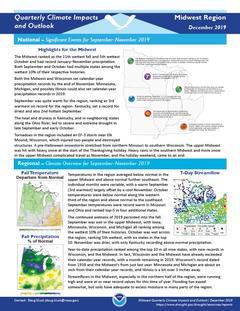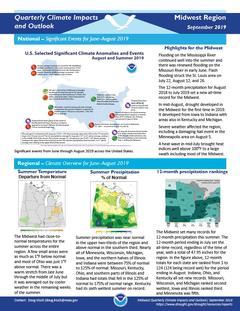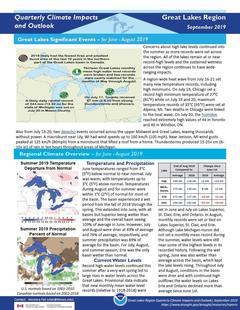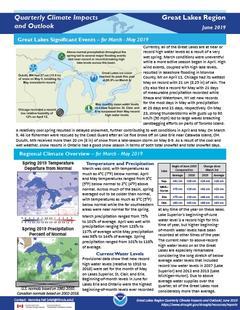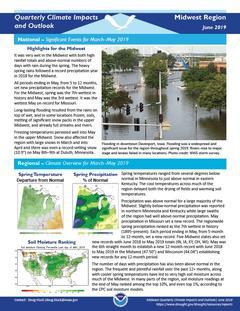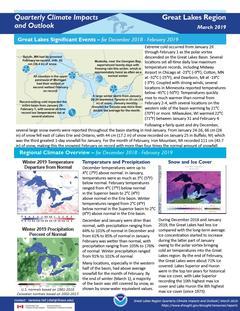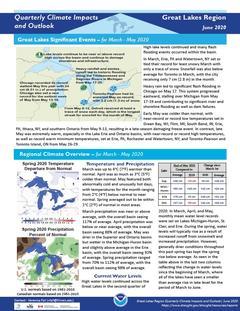For the latest forecasts and critical weather information, visit weather.gov.
Quarterly Climate Impacts and Outlook for the Great Lakes Region for December 2019 – February 2020. Dated March 2020.
Most of the Great Lakes states had one of their top 10 warmest winters on record. Winter was drier with the basin seeing 84% of average. There was below average ice cover due to warm air temperatures and lack of consecutive days below freezing.
Quarterly Climate Impacts and Outlook for the Midwest Region for September – November 2019. Dated December 2019.
Temperatures in the region averaged below normal in the upper Midwest and above normal further southeast. The continued wetness of 2019 persisted into the fall. Year-to-date precipitation ranked among the top 10 in all nine states, with new records in Wisconsin, and the Midwest.
Quarterly Climate Impacts and Outlook for the Great Lakes Region for September – November 2019. Dated December 2019.
Autumn temperatures ranged from 2°C (4°F) below normal to 2°C (4°F) above normal. Autumn precipitation ranged from 88% to 125% of average, with the overall basin seeing 115% of average.
Quarterly Climate Impacts and Outlook for the Midwest Region for June – August 2019. Dated September 2019.
The Midwest had close-to-normal temperatures for the summer across the entire region. Summer precipitation was near normal in the upper two-thirds of the region and above normal in the southern third.
Quarterly Climate Impacts and Outlook for the Great Lakes Region for June – August 2019. Dated September 2019.
June temperatures ranged from 3°C (5°F) below normal to near normal. July was warm, with temperatures up to 3°C (5°F) above normal. Temperatures during August and for summer were within 1°C (2°F) of normal for most of the basin. The basin experienced a wet period from the fall of 2018 through the spring. This extended into June, with all basins but Superior being wetter than average and the overall basin seeing 109% of average in June.
Quarterly Climate Impacts and Outlook for the Great Lakes Region for March – May 2019. Dated June 2019.
Across much of the basin, spring averaged out to be colder than normal, with temperatures as much as 3°C (5°F) below normal while the far southeastern areas were near normal for the spring. Spring precipitation ranged from 101% to 118% of average.
Quarterly Climate Impacts and Outlook for the Midwest Region for March – May 2019. Dated June 2019.
Spring temperatures ranged from several degrees below normal in Minnesota to just above normal in eastern Kentucky. Precipitation was above normal for a large majority of the Midwest.
Quarterly Climate Impacts and Outlook for the Midwest Region for December 2018 – February 2019. Dated March 2019.
Winter temperatures for the 3-month period of December to February ranged from a few degrees below normal in the northwest to a few degrees above normal in the southeast. Precipitation was well above normal in the Midwest, ranking as the third wettest winter back to 1895.
Quarterly Climate Impacts and Outlook for the Great Lakes Region for December 2018 – February 2019. Dated March 2019.
Winter temperatures ranged from 2°C (4°F) below normal in the Superior basin to 2°C (4°F) above normal in the Erie basin. Winter precipitation ranged from 91% to 101% of normal.
Quarterly Climate Impacts and Outlook for the Great Lakes Region for March – May 2020. Dated June 2020.
Spring temperatures averaged out to be within 1°C (2°F) of normal in most areas. Spring precipitation ranged from 70% to 112% of average, with the overall basin seeing 98% of average.



